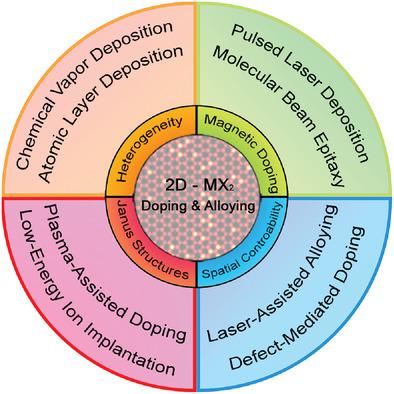Our official English website, www.x-mol.net, welcomes your feedback! (Note: you will need to create a separate account there.)
Controllable Thin‐Film Approaches for Doping and Alloying Transition Metal Dichalcogenides Monolayers
Advanced Science ( IF 15.1 ) Pub Date : 2021-02-26 , DOI: 10.1002/advs.202004249 Yu-Chuan Lin 1 , Riccardo Torsi 1 , David B Geohegan 2 , Joshua A Robinson 1, 3, 4 , Kai Xiao 2
Advanced Science ( IF 15.1 ) Pub Date : 2021-02-26 , DOI: 10.1002/advs.202004249 Yu-Chuan Lin 1 , Riccardo Torsi 1 , David B Geohegan 2 , Joshua A Robinson 1, 3, 4 , Kai Xiao 2
Affiliation

|
Two‐dimensional (2D) transition metal dichalcogenides (TMDs) exhibit exciting properties and versatile material chemistry that are promising for device miniaturization, energy, quantum information science, and optoelectronics. Their outstanding structural stability permits the introduction of various foreign dopants that can modulate their optical and electronic properties and induce phase transitions, thereby adding new functionalities such as magnetism, ferroelectricity, and quantum states. To accelerate their technological readiness, it is essential to develop controllable synthesis and processing techniques to precisely engineer the compositions and phases of 2D TMDs. While most reviews emphasize properties and applications of doped TMDs, here, recent progress on thin‐film synthesis and processing techniques that show excellent controllability for substitutional doping of 2D TMDs are reported. These techniques are categorized into bottom–up methods that grow doped samples on substrates directly and top–down methods that use energetic sources to implant dopants into existing 2D crystals. The doped and alloyed variants from Group VI TMDs will be at the center of technical discussions, as they are expected to play essential roles in next‐generation optoelectronic applications. Theoretical backgrounds based on first principles calculations will precede the technical discussions to help the reader understand each element's likelihood of substitutional doping and the expected impact on the material properties.
中文翻译:

用于掺杂和合金化过渡金属二硫族化物单层的可控薄膜方法
二维(2D)过渡金属二硫属化物(TMD)表现出令人兴奋的特性和多功能材料化学,在器件小型化、能源、量子信息科学和光电子学方面具有广阔的前景。它们出色的结构稳定性允许引入各种外来掺杂剂,这些掺杂剂可以调节其光学和电子特性并诱导相变,从而增加磁性、铁电和量子态等新功能。为了加速其技术准备,必须开发可控合成和加工技术来精确设计 2D TMD 的成分和相。虽然大多数评论都强调掺杂 TMD 的特性和应用,但本文报道了薄膜合成和加工技术的最新进展,这些技术显示出 2D TMD 替代掺杂的优异可控性。这些技术分为自下而上的方法和自上而下的方法,前者直接在基板上生长掺杂样品,后者使用能量源将掺杂剂注入现有的二维晶体中。VI 族 TMD 的掺杂和合金变体将成为技术讨论的中心,因为它们预计将在下一代光电应用中发挥重要作用。基于第一原理计算的理论背景将先于技术讨论,以帮助读者了解每种元素替代掺杂的可能性以及对材料性能的预期影响。
更新日期:2021-05-05
中文翻译:

用于掺杂和合金化过渡金属二硫族化物单层的可控薄膜方法
二维(2D)过渡金属二硫属化物(TMD)表现出令人兴奋的特性和多功能材料化学,在器件小型化、能源、量子信息科学和光电子学方面具有广阔的前景。它们出色的结构稳定性允许引入各种外来掺杂剂,这些掺杂剂可以调节其光学和电子特性并诱导相变,从而增加磁性、铁电和量子态等新功能。为了加速其技术准备,必须开发可控合成和加工技术来精确设计 2D TMD 的成分和相。虽然大多数评论都强调掺杂 TMD 的特性和应用,但本文报道了薄膜合成和加工技术的最新进展,这些技术显示出 2D TMD 替代掺杂的优异可控性。这些技术分为自下而上的方法和自上而下的方法,前者直接在基板上生长掺杂样品,后者使用能量源将掺杂剂注入现有的二维晶体中。VI 族 TMD 的掺杂和合金变体将成为技术讨论的中心,因为它们预计将在下一代光电应用中发挥重要作用。基于第一原理计算的理论背景将先于技术讨论,以帮助读者了解每种元素替代掺杂的可能性以及对材料性能的预期影响。



























 京公网安备 11010802027423号
京公网安备 11010802027423号